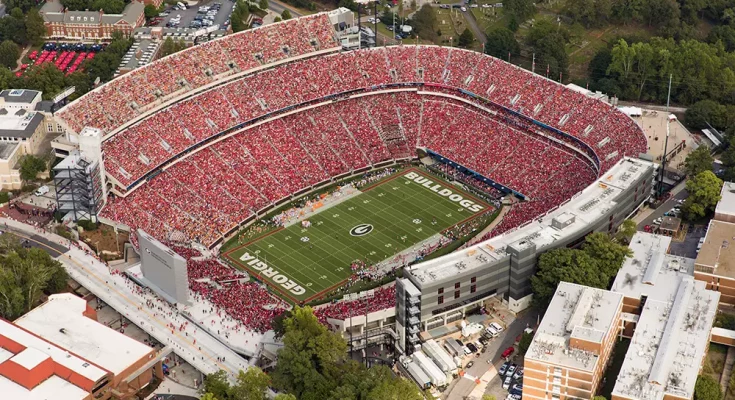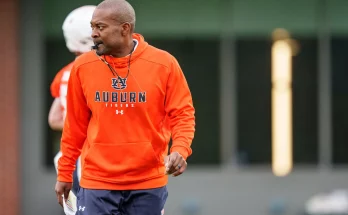Sanford Stadium, home of the Georgia Bulldogs, is one of the top ten college football venues.
Sanford Stadium, officially known as Dooley Field at Sanford Stadium, is home to the Georgia Bulldogs and one of the most storied arenas in college football. Built in 1929 and expanded multiple times since including major work in 2003, 2004, and 2018 the stadium now seats 93,033 fans, making it the ninth largest on‑campus stadium in the NCAA. With its famous hedges surrounding the field, Sanford Stadium is instantly recognizable as one of the most beautiful and iconic venues in the country .
From the outside, the stadium’s symmetrical design, lush grass field, and tree-lined campus setting evoke tradition and serenity. But on game day, everything changes. Sanford Stadium transforms into one of the loudest, most electric environments in college football. Georgia fans, many dressed in red and black, pack every seat across the upper and lower decks. On big Saturdays especially against SEC rivals the stadium shakes with noise and energy. Athlon Sports named it one of the Top Five College Football Stadiums in the country, emphasizing both its beauty and its power as a game-day experience .
The nickname “Between the Hedges” captures more than aesthetics. The privet hedges, originally planted in 1929 and replanted in 2024 after Olympic alterations, border the field and hide the rail fence beyond. Runners and players navigating sidelines are literally framed by those hedges, lending the stadium its magical reputation. It’s an old tradition that feels new every fall .
Where ranking by capacity matters, Sanford Stadium stands tall. In listings of the biggest NCAA stadiums for the 2025–26 season, it ranks at No. 9, just behind giant venues like Kyle Field and Ohio Stadium, but ahead of other historic bowls like the Rose Bowl. Its capacity of over 92,000 consistently brings top attendance numbers and ranks among the top ten in national attendance averages as well
Beyond size, the stadium’s atmosphere is frequently ranked among the nation’s most intimidating environments. 247Sports placed it at No. 4 among the most difficult stadiums to play in, describing Athens as hostile to opponents and bolstered by Georgia’s impressive home win streak and packed crowds. GameSpot’s CFB 26 rankings list Sanford Stadium at No. 4 among toughest venues, ahead of Bryant-Denny and Clemson, with Beaver Stadium and Ohio Stadium above it. Fans online emphatically agree: some say it’s the most authentic college football setting in the South—others even rank it second only to Tiger Stadium in terms of intimidation .
Georgia’s success under Kirby Smart has added to the mystique. The Bulldogs have won multiple national championships recently, and Sanford Stadium is viewed as a fortress. Spring games, Tailgate rows, bell-ringing traditions, and packed seats starting at kickoff all contribute to the energy. Even ESPN and SI have ranked it in their top-ten hardest stadiums, citing how impactful the crowd, student section, and game-day rituals can be .
Walking into Sanford on a Saturday feels like being part of something bigger. Few campuses can rival how close the stadium sits to student unions, The Arch, and academic halls. Saints or visitors feel the crowd pressing from three sides, creating a claustrophobic but thrilling effect. The tradition of rushing the chapel bell after big wins once limited to freshmen and now open to alladds life and unity across the fanbase. Touching the hedges before kickoff is considered good luck a gesture that connects players and fans across generations .
Inside, high-quality renovations including new locker rooms, recruiting spaces, video boards, and expanded suites have brought modern infrastructure while preserving the stadium’s classic look. SkySuites, widened concourses, luxury accommodations, and a new west end plaza all make Sanford Stadium competitive with the most advanced venues in college football
Opponents have often remarked on the difficulty of seeing or hearing fundamentals at Sanford. The playing field orientation, east–west against most stadiums, occasionally puts the sun at players’ faces. The hedges not only beautify the sideline it contains sound, forcing noise inside. If the Bulldogs score early, the decibels rise to near stadium-shaking levels as fans bounce, chant, and create an opposing nightmare .
Local media and fan forums frequently list Sanford Stadium among the all-time greats even those not Georgia fans describe visiting it as a bucket-list destination. Reddit users have argued it doesn’t need to be in the top 3 “Top 10 for sure,” one fan said but added that a packed game against Tennessee or Florida can feel like an earthquake in real time
Consider all factors attendance, design, tradition, noise, campus integration, and fan commitment and Sanford Stadium checks every box. It is one of the country’s largest venues, ensures intimidation factor through volume and design, and upholds rich game-day tradition unmatched by many programs.
Even assignments like hosting 1996 Olympic soccer games required temporary hedge removal, which Georgia fans handled with ceremony and secrecy. The hedges were later replanted from cuttings and preserved offsite during the competition. That commitment to legacy balancing modern needs with historic traditions helps explain why the stadium still resonates with emotion nearly a century after opening
National publications confirm what fans feel on Saturdays. Sanford Stadium routinely appears in top rankings of best stadiums to visit, most beautiful venues, or toughest places to be an opponent. Bleacher Report placed it at No. 7 in a power ranking of BCS-era stadiums, lauding its unique student section, massive 92,746 capacity, and unmatched atmosphere when Georgia delivers strong seasons
Georgia athletic officials also know how much impact the stadium holds. Home attendance has ranked in the top ten nationally for over twenty years. That consistency matters it means fans buy in even in down years and create a living legacy for recruits and opposing teams to feel immediately
For Georgia fans, Sanford Stadium is more than just turf and stands. It’s identity, history, and pride. From the hedges to the bell, to traditions like the “UGA Walk” and “Ring the Bell,” game day starts long before kickoff. Fans tailgate under oaks, line up for the classic Milledge Avenue walk, and gather at Tate Plaza before funneling into a stadium known for its hush-breaking chants and a roar that reverberates across Athens.
Even in 2025, as college football grows globally, Sanford Stadium continues to stand among the top ten venues in the sport. It blends size ninth-large in capacity with unmatched aesthetics, tradition, and game-day energy. It’s a stadium built for football, community, and legacy.
So yes, Sanford Stadium is one of the top ten college football venues and for good reason. Every fall Saturday in Athens reinforces that reputation, whether through epic finishes, packed crowds, historical architecture, or the thrill of being Between the Hedges.



